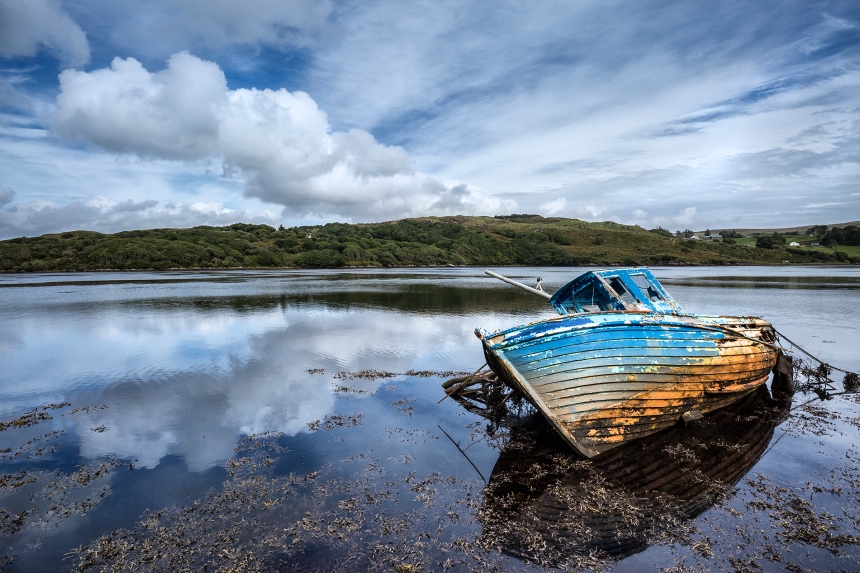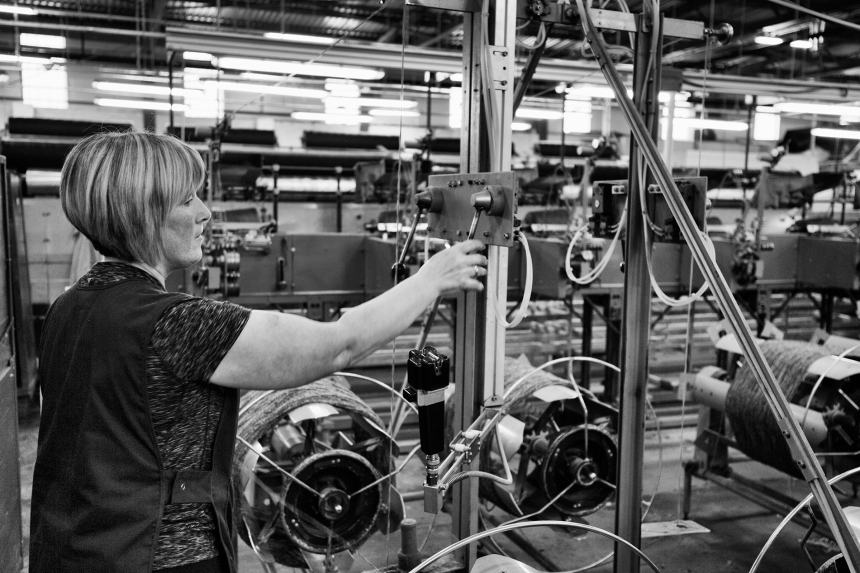We are all busy here behind the scenes – putting the finishing touches to the pattern collection that will be released as part of our forthcoming club, and awaiting the arrival of our new and much-anticipated yarn – Milarrochy Tweed.

Milarrochy Tweed is produced for us by our friends at Donegal Yarns – a company I’m really excited to finally be working with. Because my love affair with Donegal tweed goes back a few years . . . In 2012, I’d started working with a few different yarns that were being produced by a mill in Kilcar, Donegal. These yarns were nothing like anything I’d knit with before, so Mel and I decided to visit Donegal to see what was going on there.

We were impressed with everything we saw: a small company embedded in its local community and landscape, creating really distinctive yarns with a long history in the area, whose success and longevity were entirely due to the commitment and expertise of the women and men who worked so hard to produce it.

What makes Donegal tweed yarns so distinctive? They are generally single ply, woollen spun, richly saturated, and peppered with neps and flecks which lends every strand of every shade an unusual depth and complexity.

Whichever fibre blend is used to produce them (and several interesting blends are produced here at Kilcar) to my mind, Donegal tweeds are dream yarns for colourwork: ideally suited to bold contrasts as well as subtle tonal effects, while the neppy nature of the strands lifts the surface of a fabric and really makes it sing. I just love working with these yarns, and, as you can well imagine, am incredibly excited to now be able to produce my own small tweedy range from fibres dyed and spun at this mill – named after my own Scottish locale – that bears so many similarities with the Irish landscape where it was created.

A few weeks ago, I returned to Donegal with Tom, so we could see the processing of our yarn first-hand. The mill operates on a completely vertical system – which mean that all initial stages of the yarn’s processing are carried out in-house.
A Donegal tweed yarn starts life as a bale of scoured fibre . . .

The yarn is “dyed in the wool” in vats like this one.

The mill operates on a strict dyeing schedule, which means that shades of like nature are always processed back to back to ensure consistency of colour. No point juxtaposing a pale blue with a deep red!





When the wool comes out of the dye vat, it is a completely solid colour.

In order to make a solid into a tweed, you have to blend it, and in order to blend it, you have to follow the wool on its journey to the most exciting place in the mill. . . .
The blending room!

IT’S RAINING NEPS! HALLELUJAH, IT’S RAINING NEPS!
Can you imagine working in here? The urge to hurl myself with wild abandon into the woolly snowstorm was really pretty strong. . .

But there is work to be done and yarn to be made. . .
Once the dyed wool is blended with the colourful neps, it enters a fascinating tubular system (which resembles those interesting money-funnels you once routinely saw in supermarkets and department stores) and travels through the mill upstairs . . . to be carded . . .

. . . drawn, twisted . . .


realigned, and drawn again


. . . until it forms a workable sliver . . .

. . . which is ready to be spun.

Back downstairs, the air is filled with the sound of the spinning mules and winders whirring back and forth.

The technology is efficient, but this is in no sense an automated process.

At every stage of the yarn’s processing, skilled hands are involved.




. . . resulting in the beautiful, flecky, truly distinctive yarns known as “the genuine Donegal”.

We really enjoyed following Milarrochy Tweed from its beginnings as scoured fibre to the lovely spun-up end product here at Donegal Yarns, and Tom took many more fantastic photos than I have showed here. Perhaps I’ll share some more another time.

A massive thanks to everyone at Donegal Yarns in particular Chris Weiniger (above) whose knowledge of textiles and sheer commitment to what he does always impresses. Especial thanks to Seamus Campbell (pictured in this post’s fourth photograph) – a man of many talents and much woolly acumen with whom I really enjoyed chatting.


Beautiful story, Kate! Thanks for sharing! Can’t wait to knit with this yarn!
LikeLiked by 1 person
A wonderful story beautifully conveyed. Can’t wait to get some!
LikeLike
Absolutely fascinating ! I have to admit I hadn’t really thought about the processes before. I have a new appreciation for the people who produce these beautiful yarns.
LikeLike
how much longer, Kate?
LikeLike
Lots of anticipation for the new yarn and pattern collection. I absolutely love the photos of the hands. Something so real about those images.
LikeLike
Kate – thank you for sharing such beautiful photos!!
LikeLike
Amazing!
LikeLike
Since you first mentioned this new tweedy wool i’ve been itching to get my fingers on it. I love the anticipation of slow knitting where you can see that interesting little capsule of colour moving toward you – a really quite sensuous experience (in a low key sort of way). I have only one question: WHEN?
LikeLike
such an interesting post, thank you for showing the complexities of yarn production,
LikeLike
Fantastic Kate – I could picture ‘playing’ in the mixing unit! Thanks for sharing. X
LikeLike
Thank you for this virtual tour, Kate. It’s a fascinating process, and I can’t wait to see your new yarn with all those colourful news sprinkled through it.
LikeLike
I so appreciate you introducing all the fine folk who create such a lovely and unique wool.
It brings more connection and intimacy to the overall knitting experience.
I very much look forward to the unveiling of Milarrochy Tweed!!
LikeLike
I have a Donegal Tweed wool hacking jacket that I was lucky enough to find in a charity shop last year- just my favourite thing in my wardrobe. A rich brown from a distance, looking close up it’s speckled with so many beautiful deep colours, emerald, kingfisher blue, violet, burgandy, and is so beautifully made. It’s a Magee, and was brand new, with the labels still on. I wonder if Donegal yarns were involved in the process of its production?
LikeLike
It looks as though some of the shades are deep tones which I adore. Looking forward to this club. As a Nana of all boys might a young boys jerkin or hoody feature in your knits at some point?
LikeLike
I have loved flecked yarn all my life! This is so interesting. Thank you, once again, for the pleasure that you and Tom, and your friends, and colleagues, bring to our world.
LikeLike
Fascinating look behind the scenes – behind the scenes for most of us, that is! Thanks for sharing!
LikeLike
Yes please more photos! 😀 I had these for breakfast this morning and I’m hungry for more. Softness? Is Donegal tweed soft or coarser as the name tweed suggests? Ooh can’t wait to see the patterns. Love this post!
LikeLike
One of my favourite cardigans EVER is knitted in red Donegal tweed. It’s about 12 years old now, worn regularly and still going strong. I love this yarn, the colours are deep jewel-like and its great to knit with. Can’t wait to see what you’ll do with it, Kate.
LikeLike
How do. I get in the club?
LikeLike
Nothing but exciting news and looking forward to seeing more of the process.
LikeLike
Kate, it was a treat to read this post and to be able to see the marvelous photographs, too.
I would love to take such a Donnegal yarn tour myself, but seeing your report will reward my curiosity and enthusiasm for now.
Best wishes from New York. xo
LikeLiked by 1 person
Thank you thank you for taking us with you on an adventure to find out more about the textile industry around us that we all depend on to give us our materials. The knowledge and experience embodied here gives me so much joy. Can’t wait to see the new yarn.
And as a spinner myself, I have another burning question. Do they sell their sliver? I’m always looking for fibre from British mills and it can be tough to track down.
LikeLiked by 1 person
Please tell me that I’ve not missed a club signup!
LikeLike
I am very excited to try this new yarn. I have always had a soft spot for tweed!
LikeLike
Looking forward to the next Club!!
LikeLike
Great photos and so interesting to see the full process to the result being such beautiful, rich colourful tweed yarn
LikeLike
Thanks once more! So interesting and Tom’s pics are great.
LikeLike
Wow! And how exciting!
LikeLike
What an interesting process this is! Thank you for sharing these photos! Love the colors…especially the blue!
Julie
LikeLike
Oh so exciting! My fingers can hardly wait!
LikeLike
Lordy, Lordy, I’m in LOVE! I have some very old Donegal weed…..no idea where it was processed in Ireland but lavenders, light and deep shades. YUM thank you for that trip!!
LikeLike
Must have been processed in Donegal 🤣
LikeLike
Oh my goodness! This really whets my appetite!
LikeLike
Will there be a club for this yarn?
LikeLike
yes! the yarn is an integral part of the upcoming club.
LikeLike
Oh my! I can not wait to get my hands on this yummy yarn. Well done!
LikeLike